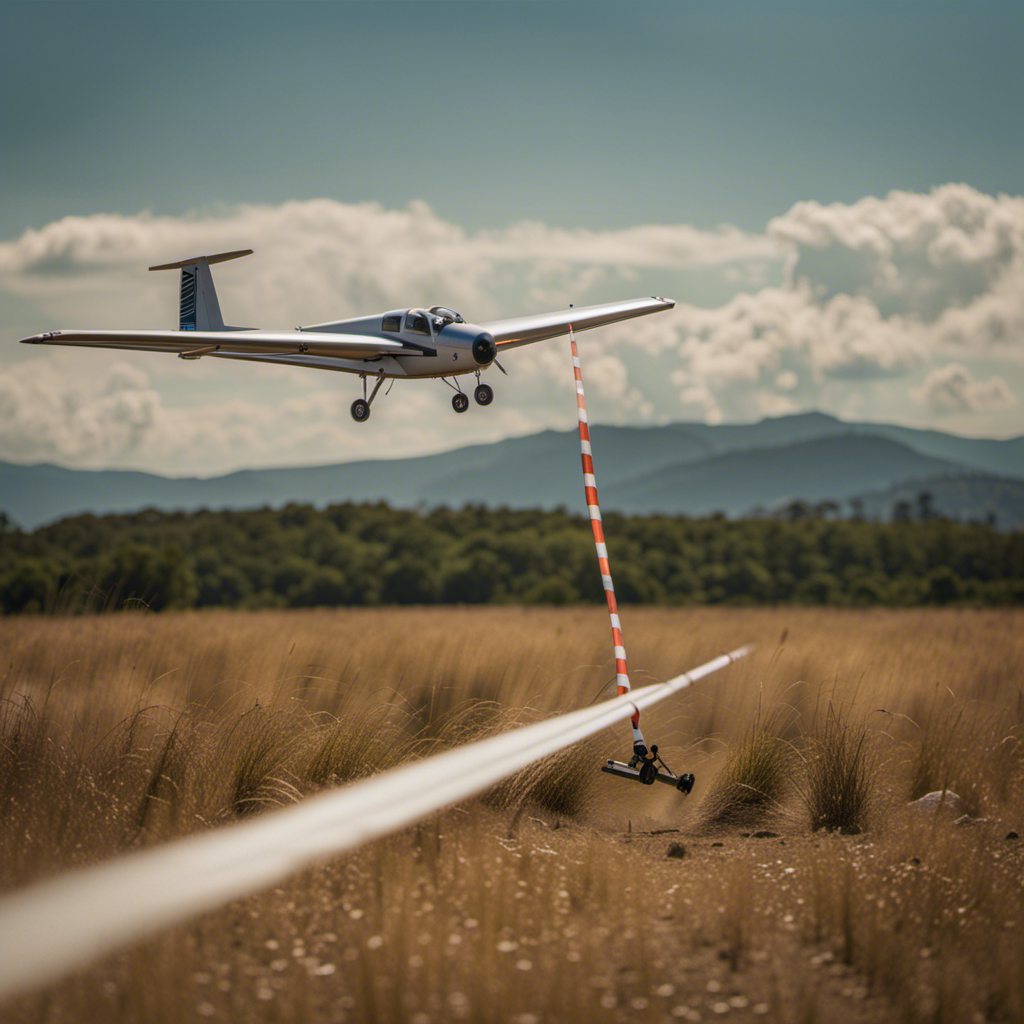Are you a new pilot excited to take flight in a glider? Gliding Safety 101: Essential Tips for New Pilots will guide you through the important aspects of safe gliding techniques.
This article will equip you with the knowledge and skills you need to ensure a smooth and secure flight. From pre-flight checklists to understanding weather conditions, proper training to emergency procedures, this comprehensive guide will help you make informed decisions and maintain a high level of safety while gliding.
So, buckle up and get ready to soar with confidence!
Key Takeaways
- Effective communication and radio etiquette are important for maintaining clear and concise communication with other pilots and air traffic control.
- Risk management and decision making are crucial for evaluating potential risks, being aware of weather conditions and hazards, and regularly assessing glider condition.
- Maintenance and inspections should be performed regularly to ensure the glider is in good condition, including thorough inspections before each flight, attention to control surfaces and connections, and regular cleaning and lubrication.
- Continuous learning and improvement are essential for staying updated with technology and safety procedures, participating in training exercises, seeking feedback from experienced pilots, and learning from their experiences.
Pre-Flight Checklist and Inspection
Before you take off, make sure you’ve completed your pre-flight checklist and inspection. This is a crucial step to ensure your safety and the proper functioning of your glider.
Start by checking the overall condition of the glider, including the wings, tail, and control surfaces. Inspect for any signs of damage, such as cracks, dents, or loose fittings.
Then, check the instruments and avionics to ensure they’re working properly. Don’t forget to inspect the parachute and harness for any signs of wear and tear.
Lastly, check the fuel and oil levels, and make sure all the required documents are on board. By diligently completing your pre-flight checklist and inspection, you can have peace of mind knowing that your glider is in optimal condition for takeoff.
Understanding weather conditions and wind patterns is the next crucial step in ensuring a safe and successful gliding experience.
Understanding Weather Conditions and Wind Patterns
Make sure you understand the weather conditions and wind patterns to ensure a safe gliding experience. Here are four essential tips to help you navigate the skies with confidence:
-
Study the weather forecast: Before you take to the skies, check the weather forecast for your area. Look for any potential storms, high winds, or other adverse conditions that could affect your flight.
-
Assess wind direction and speed: Understanding wind patterns is crucial for a successful gliding experience. Pay attention to the direction and speed of the wind, as they can greatly impact your flight path and landing.
-
Learn about local microclimates: Different areas may have unique microclimates that can create unpredictable wind patterns. Familiarize yourself with the local geography and topography to anticipate any sudden changes in wind direction or intensity.
-
Consult experienced pilots: Seek advice from experienced glider pilots who are familiar with the specific weather conditions and wind patterns of your flying area. They can provide valuable insights and guidance to enhance your safety and enjoyment.
Proper Training and Certification
To ensure your competence as a glider pilot, it’s crucial to undergo proper training and obtain the necessary certification. Gliding may seem effortless, but it requires a solid foundation of knowledge and skills to operate a glider safely.
Enroll in a reputable glider pilot training program that covers essential topics such as aerodynamics, meteorology, navigation, and emergency procedures. Through comprehensive theoretical lessons and practical flight training, you’ll develop the necessary expertise to handle a glider confidently.
Certification is equally important as it validates your competence and adherence to safety standards. Once you have obtained your glider pilot certification, you can progress to the next crucial aspect of gliding safety: maintaining a safe distance from other aircraft.
It’s essential to understand and follow the regulations and procedures that govern airspace usage to ensure the safety of yourself and others.
Maintaining a Safe Distance from Other Aircraft
Once you’ve obtained your glider pilot certification, it’s crucial to maintain a safe distance from other aircraft. As a glider pilot, you are responsible for your own safety and the safety of others in the sky. Keeping a safe distance from other aircraft is essential to avoid mid-air collisions and ensure a smooth and enjoyable flight experience.
Always be aware of your surroundings and constantly scan the sky for any potential traffic. Use your radio to communicate with other pilots and air traffic control to establish your position and intentions. Additionally, familiarize yourself with the airspace regulations and adhere to them strictly.
By maintaining a safe distance from other aircraft, you can mitigate the risk of accidents and ensure a safe and successful gliding experience.
Now, let’s move on to discussing emergency procedures and equipment.
Emergency Procedures and Equipment
When facing an emergency situation in the air, remember to rely on your training and the available equipment to ensure your safety. As a new pilot, it is crucial to be prepared for any unforeseen circumstances that may arise during your gliding journey.
Familiarize yourself with the emergency procedures specific to your aircraft, such as engine failure or control malfunctions, and practice them regularly. Make sure you know the location and operation of all emergency equipment on board, including fire extinguishers, first aid kits, and emergency locator transmitters.
In addition, maintain your equipment in good working condition, conducting regular inspections and servicing as required. By being well-prepared and knowledgeable about your emergency procedures and equipment, you can significantly increase your chances of safely managing any unexpected situations.
Developing good situational awareness is the next crucial step in becoming a proficient glider pilot.
Developing Good Situational Awareness
Now that you are familiar with emergency procedures and the necessary equipment, it’s time to focus on developing good situational awareness.
As a new pilot, being aware of your surroundings is crucial for maintaining safety during gliding. Situational awareness involves continuously monitoring the environment, understanding the potential risks, and making informed decisions to mitigate them.
By staying alert and observant, you can anticipate changes in weather conditions, identify potential hazards such as other aircraft or obstacles, and adjust your flight path accordingly. Additionally, maintaining situational awareness allows you to effectively communicate with air traffic control and other pilots, ensuring smooth coordination and avoiding potential conflicts.
Developing this skill will not only enhance your safety but also contribute to a more enjoyable and fulfilling gliding experience.
Speaking of communication, let’s now delve into the important aspect of communication protocols and radio etiquette.
Communication Protocols and Radio Etiquette
To effectively communicate with air traffic control and other pilots, it’s important to understand and adhere to proper communication protocols and radio etiquette. Here are some essential tips to ensure clear and efficient communication during your flights:
-
Use standard phraseology: Familiarize yourself with the standard phrases and terms used in aviation communication to ensure clarity and avoid misunderstandings.
-
Speak clearly and concisely: Enunciate your words clearly, and keep your transmissions brief and to the point. Avoid unnecessary chatter that can clog up the radio frequency.
-
Listen actively: Pay attention to radio calls from other pilots and air traffic control, and acknowledge their transmissions promptly to maintain effective communication.
-
Be professional and courteous: Maintain a professional tone and remain polite and respectful when communicating with others.
By following these communication protocols and practicing proper radio etiquette, you can enhance flight safety and ensure smooth interactions with air traffic control and fellow pilots.
This will set the stage for the next important aspect of gliding safety: managing risk and making informed decisions.
Managing Risk and Making Informed Decisions
By evaluating potential risks and gathering all the necessary information, you can make informed decisions that prioritize your safety during flights. One way to effectively manage risk is to familiarize yourself with the weather conditions before taking off. Check the forecast, pay attention to wind patterns, and be aware of any potential hazards such as thunderstorms or strong crosswinds.
Additionally, it is crucial to assess the condition of your glider before each flight. Regular maintenance and inspections are essential to ensure that all components are functioning properly and to identify any potential issues. This will help prevent any accidents or malfunctions during your flight.
By prioritizing risk management and staying proactive, you can enjoy a safe and smooth gliding experience.
Now, let’s shift our focus to the importance of regular maintenance and inspections of your glider.
Regular Maintenance and Inspections of Glider
Regular maintenance and inspections are crucial to ensure that your glider is in optimal condition and to prevent any potential issues during your flights. As a new pilot, it is important to understand the significance of regular care for your glider.
Before each flight, thoroughly inspect your glider for any signs of wear or damage. Pay close attention to the control surfaces, cables, and connections. Regularly clean and lubricate the moving parts to ensure smooth operation.
Additionally, schedule periodic inspections with a certified glider technician to assess the overall condition of your glider. By staying proactive in maintaining your glider, you can minimize the risk of mechanical failures and ensure a safe flying experience.
Now that you understand the importance of regular maintenance, let’s move on to the next topic: continuous learning and improvement through experience and training.
Continuous Learning and Improvement through Experience and Training
As you gain more experience and training, you’ll find that continuous learning and improvement are key to becoming a skilled and confident glider pilot. Here are some important tips to consider:
- Stay up to date with the latest advancements in glider technology and safety procedures.
- Take part in regular training exercises to improve your flying skills and decision-making abilities.
- Seek feedback and guidance from experienced pilots to learn from their experiences and avoid common mistakes.
Conclusion
In conclusion, it’s crucial for new pilots to prioritize gliding safety. By following essential tips, you can soar through the skies with confidence.
Firstly, conducting thorough pre-flight checklists is essential. This helps ensure that all systems are functioning properly before taking off.
Secondly, understanding weather conditions is crucial. Being aware of wind patterns, cloud formations, and other factors can help you make informed decisions and avoid potentially dangerous situations.
Additionally, maintaining proper training and certification is vital. This ensures that you have the necessary skills and knowledge to handle different scenarios that may arise during your gliding experience.
Remember to always maintain a safe distance from other aircraft. This helps prevent collisions and ensures the safety of everyone involved.
Being prepared for emergencies is also important. Familiarize yourself with the necessary procedures and have the appropriate equipment on hand in case of an unexpected situation.
Adhering to communication protocols is another key aspect of gliding safety. Clear and effective communication with air traffic control and other pilots helps maintain order and prevent misunderstandings.
Lastly, continuously learning and improving is crucial. Stay informed about the latest safety guidelines and techniques, and seek opportunities to enhance your skills and knowledge.
By following these tips and prioritizing safety, you can enjoy the euphoria of gliding while ensuring your own well-being and the well-being of others.
Orion, better known as “Jetstream,” is the voice that brings the stories of the skies to life. His fascination with aviation began at a young age, sparked by his father’s tales of flying and adventure. Orion’s journey into the world of gliding was serendipitous, and from the moment he took his first glider flight, he knew he had found his calling.










